Content
- What is rosacea and why does it develop in women
- Distinguishing signs of rosacea
- Treatment regimens for rosacea in women with drugs depending on the form of the disease
- Erythematous-telangiectatic form
- Papulopustular form
- Phymatous form (rhinophyma)
- Ophthalmic rosacea
- Skin care and cosmetics
- Sun protection products
- Diet for rosacea
- Diet plan and regimen
- Allowed and Prohibited Products
- Sample menu for 3 days
- Is it possible to completely cure the disease, how long does the therapy last?
- Rosacea video
Rosacea, an inflammatory skin disease impairing the quality of life in women. The treatment regimen includes taking medications, laser therapy, gentle skin cleansing.
What is rosacea and why does it develop in women
Rosacea is a chronic, recurrent inflammatory condition of the skin, characterized by severe damage to the central part of the face. The disorder is characterized by the appearance of transient or persistent erythema, inflammatory papules or pustules, hyperplasia of the connective tissue.
Rosacea tends to affect fair-skinned people between the ages of 30 and 50, and have a history of blushing easily. Women develop more often, but men are more likely to develop lumpy, enlarged skin around the nose - a condition called rhinophyma. A bulging red nose is often viewed as a "drunkard's nose." However, rosacea has nothing to do with alcohol abuse.
The more frequent development of the disease in women, according to doctors, is associated with the immune system. Women tend to be at high risk for autoimmune disease, suggesting a more reactive immune response to certain stimuli. It is possible that female sex hormones also interact with genes in such a way that they affect the immune system.
Rosacea (the treatment regimen for women is not much different from male therapy) is sometimes mistaken for a sunburn and therefore the disease is difficult to diagnose.
The etiology of the skin disorder is unknown, but is likely multifactorial. Causes affecting the pathophysiology include the dense presence of sebaceous glands on the face, the physiology of nerve innervation, and the vascular composition of the skin.
There are various theories as to the cause. One is that the disorder may be a component of general blood vessel disease. Other theories suggest that the condition is caused by microscopic skin mites, fungus, psychological factors, or impaired connective tissue function under the skin.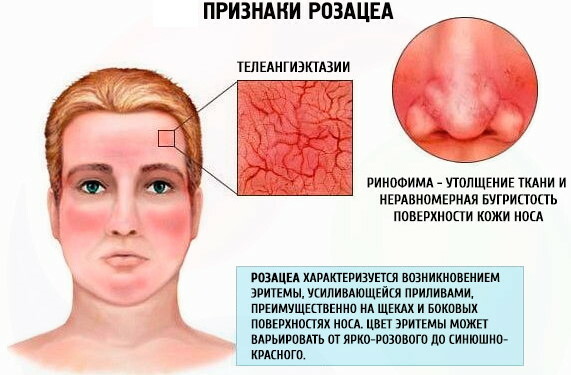
Numerous triggers initiate or worsen the clinical manifestations of rosacea:
- cold, heat and sudden temperature changes;
- excessive sweating;
- spicy dishes;
- alcohol;
- stress;
- cosmetics based on fatty oils.
There is no cure for rosacea, but certain treatments can improve the skin's appearance and well-being.
Distinguishing signs of rosacea
Rosacea (the treatment regimen for women depends on the form of the disease) is a chronic disease. Transient erythema or redness usually lasts less than 5 minutes, can go to the neck, chest, often accompanied by a feeling of warmth.
Less common signs include:
- erythematous plaques;
- peeling, swelling of the skin;
- phymatous changes (thickening of the skin due to hyperplasia of the sebaceous glands);
- eye symptoms.
Rosacea is often misdiagnosed as acne vulgaris, photodermatitis, seborrheic dermatitis, or contact dermatitis. Less common mimicking conditions include systemic lupus erythematosus, atopic dermatitis, folliculitis, bromoderma, and mastocytosis.
Skin conditions that have similarities to rosacea:
| Disorders | Features |
| Acne | Comedone formation. No eye symptoms. |
| Contact dermatitis | It is associated with itching and often resolves over time after removal of the pathogen. |
| Photodermatitis | The rash appears on several parts of the body when exposed to sunlight. |
| Seborrheic dermatitis | Has a clear distribution pattern affecting the scalp, eyebrows and nasolabial folds. |
| Systemic lupus erythematosus | Rarely there are pustules. |
The disease has varying degrees of severity, while the symptoms are expressed in different ways. Large, raised, confluent lumps and inflamed pustules develop on the forehead, cheeks, and chin, and sebaceous glands in the skin produce excessive amounts of fat. In the early stages, a fleeting, sudden redness of the face is typical. Doctors call this "hot flush", which is caused by irritants and then manifests itself in different forms.
-
1 degree. The appearance of red spots on the cheeks. At this stage, pronounced redness or red spots on the face are not short episodes, but last long or do not go away at all. In addition to redness, visible dilation of small blood vessels on the cheeks, telangiectasia or rosacea are characteristic. Patients often complain of dryness, peeling, burning and itching. At this stage, the skin disease can be treated with cosmetic methods, after which it often remains at this stage without progression.

- 2nd degree. Inflamed pustules appear, as with the development of acne. At this stage, the disease is often associated with acne (acne vulgaris). In addition to single or group erythema, there are symmetrically located papules and pustules. They persist for several weeks and can spread all over the face. However, unlike acne, there are no blackheads (comedones).
- Degree 3. In addition to other symptoms that appear (redness, inflamed pustules), bulbous formations that occur mainly on the nose (rhinophyma) and chin, but can also be on the forehead, ears or eyelids. This condition is particularly stressful for the patient.
It is still unknown how the acute form of rosacea develops. However, it does not become chronic. Rapidly onset rosacea occurs exclusively in young women (mostly between the ages of 20) during and after pregnancy.
Treatment regimens for rosacea in women with drugs depending on the form of the disease
In women, rosacea, when neglected, causes the development of purulent pustules and papules that resemble acne. Unlike acne, rosacea patients do not suffer from clogged pores and blackheads that result from excessive sebum production.
Accordingly, skin care recommended for acne cleansing is counterproductive therapy for rosacea, and often aggravates symptoms. Precisely because it is not so easy for a layman to recognize the difference between rosacea and acne, the affected person should definitely consult a dermatologist who will make the correct diagnosis and recommend the optimal treatment regimen and proper care behind the skin.
The disease cannot be cured, but it must be treated without fail, since it is amenable to correction. Therapy is primarily aimed at relieving symptoms and minimizing serious relapses.
Low-dose antibiotics and other anti-inflammatory drugs are mainly used for drug treatment. In most cases, it is sufficient to apply them externally - in the form of a cream, gel or lotion. Only in the case of a severe and therapeutically resistant course of the disease, oral medications are prescribed, which patients often use in combination with a cream or gel.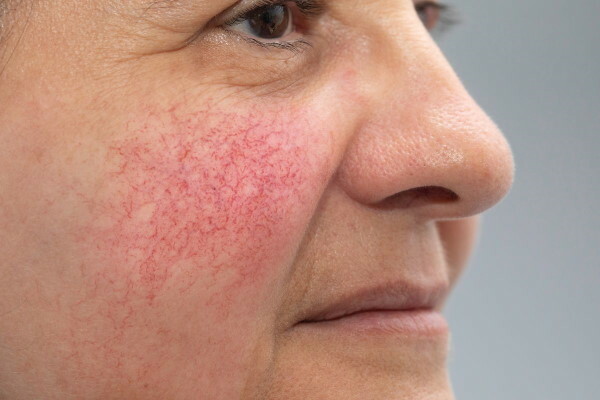
There are several subtypes of rosacea, which differ in the method of treatment.
Erythematous-telangiectatic form
This form is characterized by hyperemia and persistent central erythremia of the face. Redness captures the peripheral areas of the ears, neck, face, upper chest.
It is distinguished by the appearance of borderline forms - transient - redness, turning into a persistent telangiectasia syndrome - the appearance of spider veins. Accompanies the disease with the spread of edema.
Treatment consists of laser or light therapy. The method affects the vessels of the skin, reducing their lumen. Vessels become less visible.
Pharmacological treatment includes the use of vasoconstrictor receptor agonists. They lead to constriction of blood vessels, making them less visible.
Papulopustular form
The appearance of papules and pustules - rashes and pustules on the skin - are characteristic signs of this form of the disease.
Rosacea (the treatment regimen for women includes both external and internal agents) is treated with systemic therapy:
-
Metronidazole. Oral administration of 1.0 - 1.5 g of the drug per day for 4 or 5 weeks is proposed, it can be used up to 7-8 weeks. A cream (1%) or gel (0.75%) is used for external treatment, which is applied to the skin in a thin layer. Effectively applied twice a day, morning and evening before bedtime. The course of treatment is from 3 to 8 weeks.

- Ivermectin. Face ointment, applied once a day, daily. The course of treatment is from 2 to 4 months.
- Azelaic acid. An acid-based gel or cream is applied to the affected area twice a day (in the morning and before bedtime). To cover the entire front surface, no more than 2.5 cm is enough. strips of cream. Improvement is usually seen after 4 weeks, but for best results it is recommended to use the ointment for several months.
In severe cases, oral antibiotics are used: Doxycycline (4-week course) or Minocycline. Since the disease is chronic, it is important to follow supportive therapy - short courses of tetracycline antibiotics.
The darsonvalization method is used to normalize the secretion of the sebaceous glands and accelerate the healing of rashes.
Phymatous form (rhinophyma)
This type of disease is characterized by the appearance of skin thickening, tuberosity and pineal neoplasms near the nose, on the forehead, chin, eyelids.
At the initial stage, Isotretinone is effective, which is administered orally 0.1-0.3 m / kg. Take it 1 time per day after eating for 3-5 months. Before the appointment, as well as throughout the entire period of treatment, blood biochemical parameters should be checked and kept under control.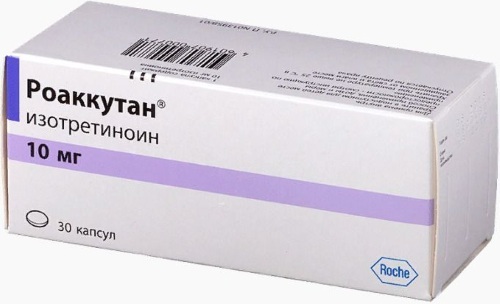
In the later stages of the development of the disease, laser or surgical intervention is used. After removal of the hyperemic areas under local or general anesthesia, the aesthetic appearance of the affected area is recreated.
Ophthalmic rosacea
Persistent redness with the transition to the eyes develops as a concomitant stage of any subtype of rosacea. Differs in the development of: blepharitis (irritation of the mobile eyelid), conjunctivitis (inflammation of the transparent membrane of the eyes). In a severe stage, keratitis, iridocyclitis (inflammation of the anterior choroid) and scleritis (a process that affects the sclera) appear.
Treatment is prescribed depending on the stage of the disease. In a mild case, special eyelid hygiene and tear substitutes are used. A moderate course is stopped by taking antibiotics and anti-inflammatory drugs. Treatment of severe cases is mainly surgical.
Signs and symptoms of ocular syndrome can develop before, during, or after cutaneous rosacea. They can also start individually, regardless of the presence of the disease on the skin. The symptoms of ocular rosacea will persist until they are relieved. To minimize or control symptoms, proper treatment should be given.
Signs of ophthalmic rosacea:
- dry eyes;
- eye itching, burning, redness;
- a feeling of the presence of a foreign body in the eyes;
- blurry vision;
- photophobia;
- swollen eyelids;
- dilation of small blood vessels in the eyes.
The exact causes of ocular rosacea are not known.
It is believed to arise from one or more of the following:
- hereditarily acquired components or factors;
- natural or environmental reasons;
- exposure to microbes or bacterial infections;
- blockage of the glands on the eyelids;
- ciliary mites.
Tetracycline derivatives, like Doxycycline, Erythromycin and Minocycline, are highly effective treatment options for ocular rosacea. The more severe the case, the longer the antibiotic treatment will take.
Sometimes surgery is the only effective treatment, but it has its limitations. Corneal transplantation is rarely effective because of the inflammation that prevents corneal neovascularization. New research related to surgery is ongoing.
Rosacea (the treatment regimen for women is selected taking into account the recommendations for diagnosis), ocular rosacea accompanies cutaneous rosacea, which is caused by defects in the immune system and vasoregulatory processes. Therefore, early treatment is necessary to control symptoms. A combination of topical and systemic therapy with cleansing and tear substitutes generally works best.
Skin care and cosmetics
Skin protection and proper care are essential for successful treatment. You should wash only with warm water and use gentle products.
Special lines of cosmetic products for rosacea skin care have been developed. Bioderma, Uriazh, Noreva and Aven provide a range of cosmetic products that facilitate skin care.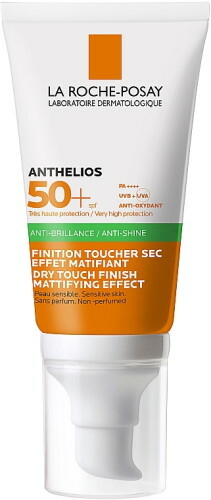
The active ingredients that make up the preparations provide counteraction to the expansion of blood vessels and the formation of capillaries. Emollient ingredients promote skin regeneration.
Sun protection products
For long-term exposure to the sun, you must apply a cream with an SPF protection of at least 30 units. With continuous exposure to the sun, for example, on the beach, you need a product with an SPF factor of at least 50 units. It should be updated every 2-3 hours.
In the cold season, you should use an oily cream. It is forbidden to use hormone-based cream. All cosmetics used must be free of vasodilating components: alcohols, heavy oils.
The use of emollients allows you to obtain a skin softening and moisturizing effect. Avoid the use of tonal agents, chemical peels.
The composition of the funds used should include:
- horse chestnut extract;
- ambophenol;
- escin;
- routine.
They improve the general condition of the blood vessels of the skin.
Diet for rosacea
Successful treatment includes dietary nutrition combined with drug therapy. It is necessary to identify and exclude the product that is the trigger of the disease. It is necessary to monitor the amount of vitamins consumed.
- Retinol or vitamin A increases the production of sebum.
- Vitamin C enhances the protective functions of the body and helps to increase the tone of the walls of blood vessels.
- Vitamin E has a normalizing effect on the blood circulation process and enhances the protective functions of the skin.
Diet plan and regimen
Experts recommend a diet that includes 25% fresh vegetables, 35% protein products, 40% grain products.
Nutrition principles:
- Food should be taken fractionally, 5-6 times a day. Portions should be small to stimulate metabolism.
- Food must be chewed thoroughly to facilitate digestion. In addition to dry foods, you should increase your fluid intake. Water, mild warm tea, herbal teas, or fresh juices are allowed to quench your thirst.
In severe cases of rosacea, fasting is recommended. It lasts no more than 5 days.
- A complete refusal to eat is observed for the first 2 days. At this time, you should drink at least 2.5 liters of mineral water.
- From day 3, it is necessary to introduce vegetable soups, boiled potatoes, cottage cheese and crackers. The use of kefir or fermented baked milk is allowed.
- On the 4th day, the addition of fish or meat is allowed.
- From day 5, it is allowed to add fresh fruits and berries to the diet.
Allowed and Prohibited Products
It is recommended to exclude the use of alcoholic beverages, strong coffee, tea. Spicy, salty and smoked foods are prohibited. The use of chocolate and spicy foods should be limited.
The diet should be dominated by vegetables and fruits. The use of dairy products is allowed. All food should be warm, but not hot.
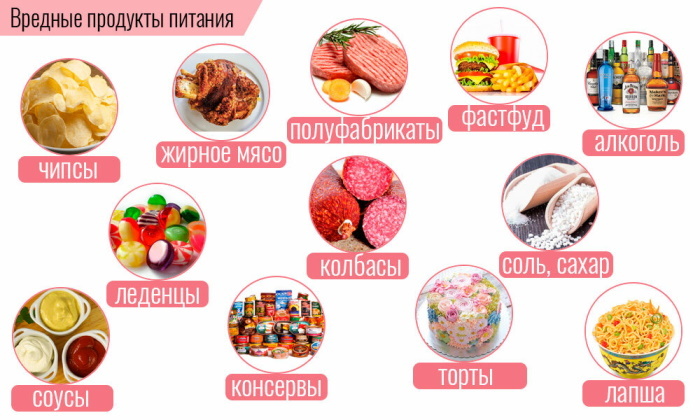
| Foods that provoke the development of the disease | Permitted products |
| Tomatoes | Asparagus |
| Hot peppers | Fresh cucumbers |
| Carrot | Green leafy vegetables |
| Beets, onions | Pumpkin, zucchini |
| Radish | Cauliflower |
| Citrus | Zucchini |
| Eggplant | Goat cheese |
| Alcohol, caffeine | Chicken eggs |
| Ginger, cumin, cloves | Salmon fish |
| Beef | Chicken |
| Seafood | Turkey |
And you should also include fruit jellies in the diet. The amino acids and collagen contained in their composition restore the elasticity of the skin.
The unsaturated fats in olive, canola and flaxseed oils improve overall skin health and increase body resistance.
Sample menu for 3 days
Rosacea (the treatment regimen for women depends on the severity of the disease) is an unpleasant dermatological disease. Depending on the subtype, it is accompanied by the appearance of negative symptoms of other systems and organs. Treatment is prescribed by a dermatologist. The menu is drawn up by a dermatologist or nutritionist.
Approximate diet for 3 days:
Day 1:
- Breakfast: low-fat cottage cheese with dried fruits.
- Lunch: vegetable salad with olive oil.
- Dinner: steamed salmon with fresh vegetables.
Day 2:
- Breakfast: natural yoghurt with fruits and nuts.
- Lunch: lean meat with rice.
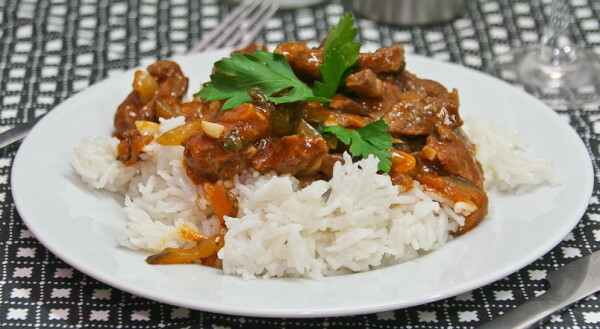
- Dinner: brown rice and rabbit stew.
Day 3:
- Breakfast: steamed wheat porridge.
- Lunch: stewed vegetables with salmon.
- Dinner: steamed chicken with asparagus and cauliflower.
For a snack between main meals, 1 glass of fermented milk products with whole grain crisps is allowed. Fruit salads are allowed as a dessert.
Is it possible to completely cure the disease, how long does the therapy last?
There is no cure for rosacea, but there are treatments that can help control symptoms. The disease can get worse if left untreated.
Particular attention should be paid to the ocular form of rosacea. In most cases, this species remains a chronic disease characterized by remission and relapses. Negative syndromes can damage the cornea. This is especially possible if the eyes are permanently dry due to the lack of tears. The affected cornea causes vision problems.
Long-term conditions that affect physical appearance always have psychological consequences. Women with rosacea feel embarrassed, frustrated, and have low self-esteem. It may seem like all hope is lost as it is an incurable disease, but it is important to note that rosacea is controllable. It is important to try available treatments and avoid flare-up triggers.
Rosacea video
Malysheva about rozcea:



